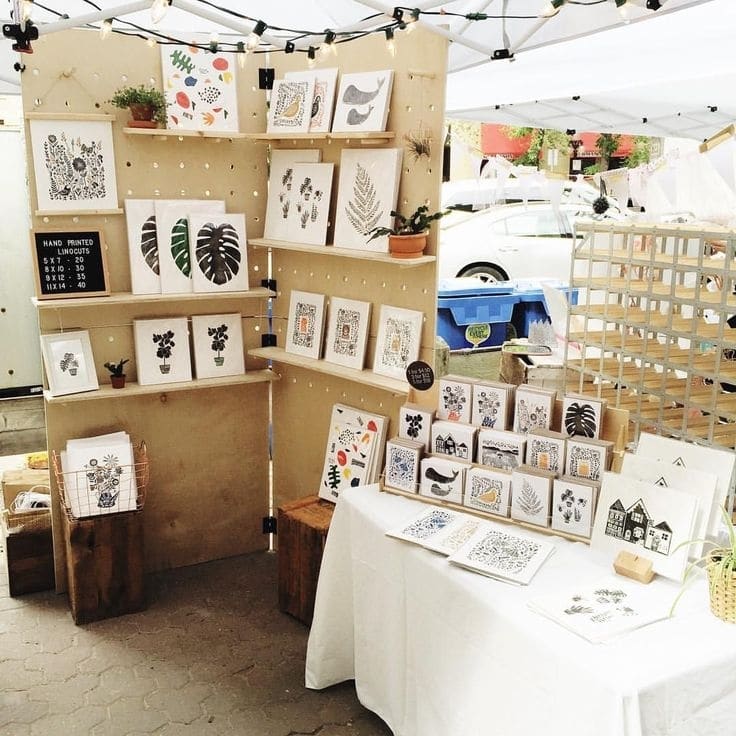Displaying your art for sale at an Arts and Crafts fair is not only a great way to generate income and get your artwork seen, but it’s also an opportunity to create a vendor booth that truly reflects your artistic vision.
Setting up an art booth requires significant effort and can be quite costly. To maximize the impact of your exhibit and ensure the best possible results, it’s worth considering these art booth display ideas for your space.
The Challenges of Making a Art Booth Display Stand Out
Putting together an art booth display stand is one of the most difficult tasks in any art show event. It involves a lot of time, effort, and money to make your booth look attractive and inviting. But with the right art show display ideas, you can create a booth space that stands out from the rest.
Visitors to an art fair are spoilt for choice, so it’s crucial that your vendor booth stands out from the rest, something that catches their attention.
In this post, we discuss different ways to make your booth stand out from the rest, including DIY techniques that can save you money. We will also talk about some of the most popular mistakes that exhibitors make and how you can avoid them. Plus, we’ll provide some tips on what to do if you have a limited budget for your exhibition booth design.
1. Vendor Booth Canopy Must be White

The color of a vendor booth canopy is crucial as it not only makes the space more aesthetically pleasing but also differentiates your exhibit from other booths at an outdoor show. It sets up a mood or tone that aligns with the artist’s goals and messages.
White Canopies: Creating an Inviting Environment
Creating an intimate and clean environment, a white booth canopy invites visitors to browse and appreciate the artwork on display. Unlike black and dark-colored canopies, which can cast a gloomy shade, a white canopy ensures the focus remains on the art pieces, allowing their colors and details to shine. Particularly beneficial in outdoor show settings, white canopies reflect light better, enhancing the visual appeal of your artwork with the aid of natural light.
The Impact of Canopy Color on Artwork Perception
While a red or blue canopy may look attractive, a white canopy brightens the booth and adds light. White is also neutral and provides a great backdrop to bring out the color and highlight your artwork. The choice of canopy color can significantly influence the perception of your artwork. For instance, a vibrant colored canopy might compete with the artwork, diverting the viewer’s attention.
Ultimately, the color of your booth canopy should complement your art and create a harmonious visual experience for the visitors, encouraging them to browse and engage with your work.
2. Don’t Forget Tent Weights to Secure Your Vendor Booth Display
It’s easy to overlook, but wind is always a factor at outdoor art shows. A sudden change in weather conditions can quickly disrupt your vendor booth setup. There are countless stories of carefully constructed booths at art festivals being toppled by an unexpected gust of wind. Ensure that your booth legs are secured to the ground and the sides are weighted to prevent movement.
Effective Vendor Booth Ideas for Stability
One solution is to use heavy steel grid wall panels that can be attached to the canopy. These not only weigh down the sides of your stand but also provide an easy way to hang your local art displays on the walls. Another cost-effective vendor booth idea is to create DIY homemade weights that you can attach to the sides of the booth.
Preparing for Unexpected Weather Changes at Art Festivals
It’s crucial to have a contingency plan in place for unexpected weather changes at art festivals. Consider investing in weather-resistant materials and covers to protect your local art and display materials from sudden rain or intense sunlight.
Monitoring Weather Forecasts and Booth Positioning for Outdoor Art Shows
It’s also advisable to keep a close eye on the weather forecast leading up to the outdoor art show and make necessary adjustments to your booth setup. If possible, position your booth in a location that offers some natural protection against the elements, such as near buildings or trees.
Remember, preparation is key when dealing with unpredictable outdoor conditions at local art exhibitions. Your art is precious, and taking these extra precautions can save you from potential losses and stress.

3. Use a Backdrop!
Artists are increasingly innovating with their booth layouts at art exhibitions, showcasing a diverse range of works from 3D sculptures to immersive sound installations. As an art vendor, the possibilities to make your booth stand out are limitless. A particularly effective strategy is the use of a backdrop. Whether it’s mounted or free-standing, the backdrop should be designed in a way that allows viewers to fully engage with your work from all perspectives, even within small spaces.
Many vendors overlook the need to display their work in a way that enhances its appeal. A back wall or curtain not only makes your booth look much more professional, but it also helps in attracting and retaining the attention of visitors.
A well-designed backdrop removes the distractions of your competition on either side of you, ensuring that visitors focus solely on your art. The backdrop itself is not just an accessory for framing; it becomes the focal point of the display and should be designed to make your work stand out.
4. Don’t Skimp on Tablecloths: Make Sure They Reach the Ground
There is nothing more unprofessional than tables with tablecloths that are not long enough and expose your packing boxes and all other kinds of things that are needed to manage a booth display. A white tablecloth or folded sheet is all you need that is long enough to hide table legs and all the junk you will store under the table. Look up “Trade Show Tablecloths” on Amazon to find good low-cost options.
In addition to maintaining a professional appearance, full-length tablecloths also offer practical benefits. They provide a hidden storage area, allowing you to keep extra inventory, personal belongings, and supplies out of sight but within easy reach. This can be particularly useful in a busy fair environment where space is at a premium.
Aa clean, well-draped tablecloth can enhance the overall aesthetic of your booth, creating an inviting and organized space for visitors. Remember, every detail of your booth contributes to the impression you make on potential buyers, so investing in quality tablecloths is a small but significant step towards success.
For more information on this topic, check out our guide on Running a Successful Art Show Booth
5. Go Vertical to Make Your Display Bigger and Eye-Catching
The floor space of your booth is typically limited in size, so make sure you use all the vertical display areas of your stand to best advantage. Back and side walls offer a great background for displaying your art – find a way to use them.
Shelving, walls, hangers, and signs – whatever it takes to make your display interesting, so you catch people’s eye as they walk past and encourage them to take a closer look.
Utilize hanging structures, like lightweight frames or tension fabric displays, to elevate your brand identity and key messages. These vertical elements not only lend depth and dimension to your stand but also have the potential to transform passing footfall into potential customers, drawn in by the visual spectacle that’s been expertly crafted.
6. Clearly Communicate What Your Art Show Booth is About
As people walk past your booth, make sure there’s no doubt about who you are and what you have to offer. Large signage or a banner that includes a tag line describing your art type and style is essential. Make it easy for them to understand your work at a glance.
Ensure your signage is visible even if your booth is full of people. It’s also a good idea to tell folks what’s for sale before they enter your stall. Are you selling originals, prints, puzzles, cards? Make your sales proposition clear together with prices. This approach encourages people to stop and browse, making it a lot easier for them to make a buying decision.
Emphasize the unique aspects of your offerings—be it the handmade authenticity of your originals, the intricate details of your prints, or the intriguing complexity of your puzzles. Use clear and attractive price labeling, preferably with a brief description of the product. This not only encourages transparency but also aids in expediting the decision-making process for potential buyers.
7. Don’t Stand “On Guard” at the Entrance.
There is nothing worse than making people feel intimidated at entering your stall. People are reluctant to enter a booth if they think they will immediately be pounced upon by the artist. Nobody will push past you to take a closer look if you’re standing there blocking it.
Stand either well outside your booth, or inside so you can greet people who show interest. Even better, perform an activity on the stand to attract attention. If you are painting a piece of artwork, people will naturally want to take a look.
Respect the space of potential customers, yet let them know you’re available for any inquiries. Offer a smile or a subtle nod to those whose eyes linger longer on your work, giving them the confidence to approach.
Be approachable and have your business cards ready. This allows interested visitors to take away a piece of your brand, making it easier for them to remember and contact you in the future.
Easy-to-Make Errors: Common Mistakes in Art Booth Displays
When it comes to showcasing your art, the above tips can make all the difference. However, even the most experienced vendors can fall into certain traps. Here are some common mistakes and how you can avoid them:
- Ignoring the Power of Lighting: Lighting can make or break the presentation of your artwork. Poorly lit booths can make your art look dull and unappealing. Invest in quality lighting fixtures to highlight your pieces and create a warm, inviting atmosphere.
- Overcrowding Your Booth: While it’s important to showcase a variety of your work, cramming too many pieces into a small space can overwhelm visitors. Ensure there’s enough space for people to move around and view your art comfortably.
- Neglecting Booth Aesthetics: Your booth should reflect the style and theme of your art. A mismatch between your booth design and your artwork can confuse visitors. Make sure your booth aesthetics align with your art style.
- Failing to Engage with Visitors: Don’t just stand by passively. Engage with visitors, answer their questions, and tell them about your art. However, avoid being too pushy. Let your visitors explore at their own pace.
- Lack of Clear Pricing: Visitors may feel uncomfortable asking about prices. Clearly label your artwork with prices to make it easier for potential buyers to make a decision.
- Not Having a Portfolio or Business Cards: Always have a portfolio or business cards handy. If visitors are interested in your work but not ready to buy, they can take your card and contact you later.
These art booth display ideas and tips apply to any art or craft show that you participate in with a booth of your own. Following the above Art Booth Display Ideas can lead to an increase in sales of your art, and make the life of a working artist just a little bit easier.






